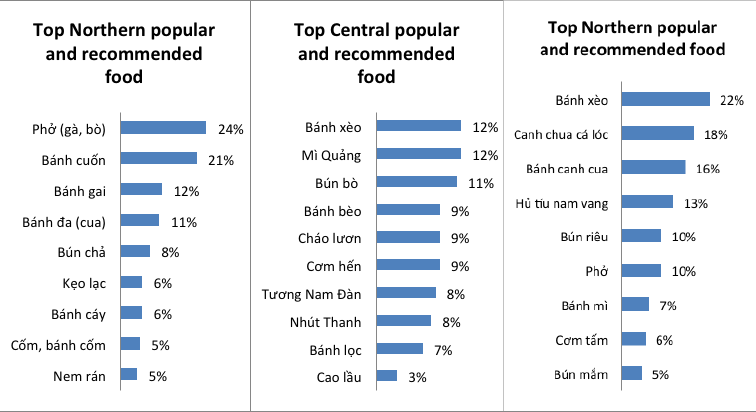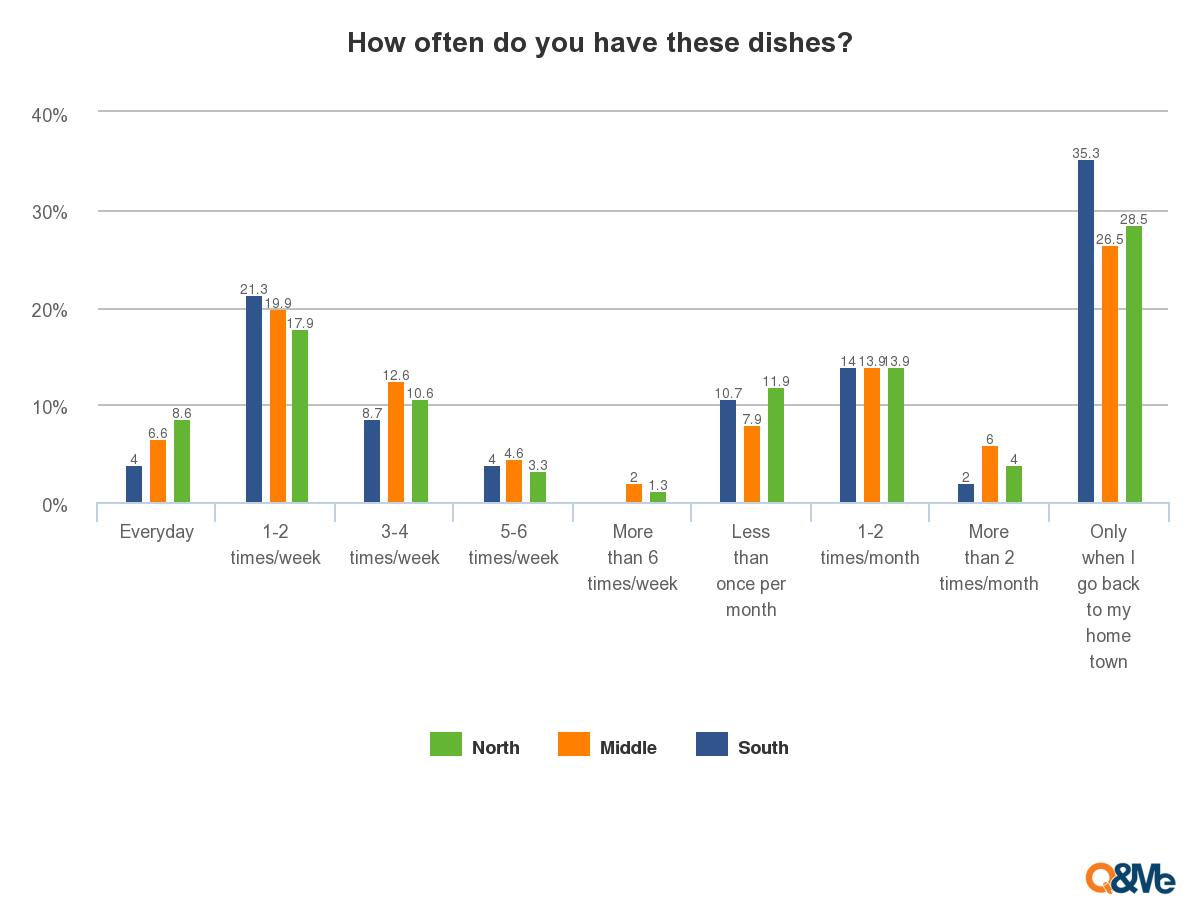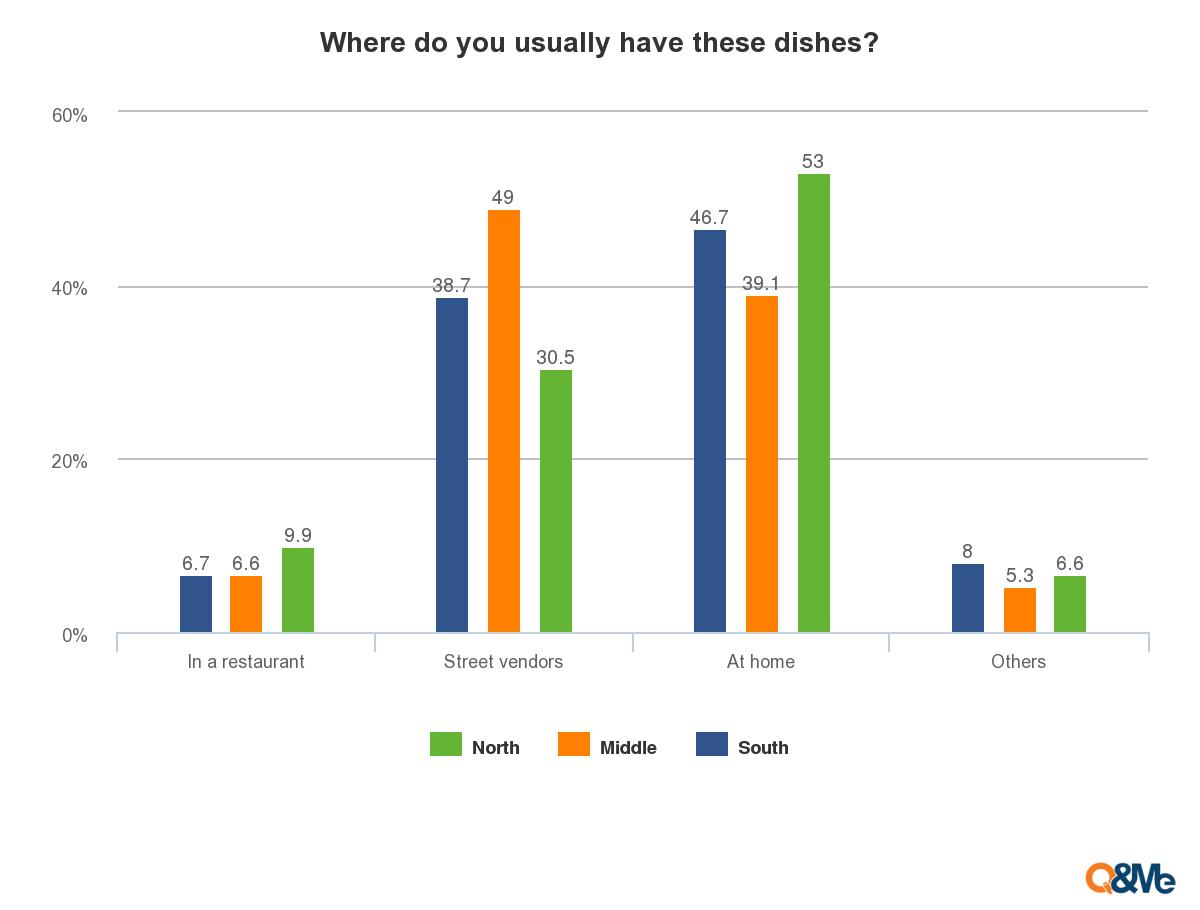-------------- Column --------------
Since Vietnam is a small country in South East Asia, a lot of people only know about Vietnam because of the war. However, they are not aware much of Vietnamese culture as well as nature and food which are very rich, deep, interesting and worth learning.
Vietnam is divided into 3 parts which are North, Central and South with the diversified differences on geography, culture, ethnics and climate. Accordingly, the food also varies from different parts of the country. Let’s have brief look at some traditional food of Vietnamese by location and recommended by local Vietnamese.

North part
The food from the northern part of Vietnam is not as bold as other parts (less spicy, fat and sweet). In addition, people here prefer to use light fish sauce. Due to the nature condition, people eat more freshwater seafood (fish, shrimp, crab, etc.) than meat.
According to our research, 5 most likable Northern dishes, voted by our panelist from the North, are listed as followed.
“Phở” (either with beef or chicken): It’s said that the dish is origin from Nam Dinh but Hanoi have made it famous. “Pho” in the north is more salty and being used without vegetables.

“Phở” with beef

“Phở” with pork
“Bánh cuốn” is produced from the north and was carried to central and the south due to the Vietnamese migration. Therefore, the way of making and eating is different as well for the location varies.
“Bánh gai” is a traditional sweet cake of Vietnam origins from delta in the North. The cake is square, black and covered by ramie leaf. It is usually used as a dessert because of its sweetness, aromatic of the stuffing inside and the sticky and cool of the cover.


“Bánh đa cua” is a special noodle dish from Hai Phong with either white or red noodle called “bánh đa” and crab.

With red noodles

With white noodles
“Bún chả” (noodle with grill marinated pork) is originated from Hanoi which is used with light fish sauce. There are 2 different types of meat” meat ball and fat flat meat. Both are well marinated then grill on the coal stove. After cooked, the meat will be dipped in the light, sweet, sour and chili fish sauce with kohlrabi (or green papaya). The dish is served with rice vermicelli and fresh vegetables

Central part
The Central cuisine is diversified, unique and colorful with the creativity gained from the hardship and poverty of the arid land.
According to our research, 5 most likable Central dishes, voted by our panelist from the Central, are listed as followed.
“Mì Quảng” is a special dish originated from Quang Nam – Da Nang. The noodle is made from powder with other additives to be chewy and crunchy. It is cooked with pork, chicken and shrimp with the broth from pork bones for intense flavor. For topping, there are hard-boiled egg, crush peanuts and steam pork sausage. It will be served with some typical and fresh vegetables, chili fish sauce and fried rice paper with sesame.

“Bánh xèo” is a Vietnamese pancake which origin is different from the central and the south of Vietnam. In the central part, this pancake is from Binh Dinh whereas in the south, it is from Khmer (an ethnic in Vietnam). The pancake in the central is small as a person’s hand and it is cooked in a clay mold with cover. The stuffing inside usually are shrimp, pork and sprout. The dish is served with bold fish sauce and fresh vegetables.

“Bún bò” is from Hue and it’s a very popular dish around the country. It contains rice vermicelli and beef with the balancing of various flavors: spicy, sour, salty, sweet and the flavor of lemon grass. It is served with raw onion and fresh vegetables. Depending on the location, the taste of “bún bò” is different to suit with the local people taste.

“Cháo lươn” is eel porridge originated from Nghe An. It is consider as lucky dish for the New Year eve for people in this area. The meat from ell will be fried with turmeric, chili and “hành tăm”- one type of shallot; then top up to the pure porridge when served. The ell bone is crushed and filtered for the water to cook in porridge. The dish is used with the fresh cilantro for the better taste.

“Cơm hến” is special meal from Hue which has main ingredient of baby basket clams and rice. The rice for this dish is medium cooked, not too sticky, not too crushed; after being cooked, cool off the rice and make it separated. The baby basket clams which is fried and added to the rice with various special additives such as shrimp paste, pork rind, the water from the baby basket clams, laksa leaf, etc. The dish is served with hot baby basket clams boiled water.

South part
The cuisine in the South is affected by cuisine of Cambodia and Thailand in which they usually add more sugar and coconut milk. Due to the geography, southern cuisine has more saltwater and brackish water seafood than the northern cuisine.
According to our research, 5 most likable southern dishes, voted by our panelist from the South, are listed as followed.
“Bánh xèo” is the pancake which was mentioned in the part of Central cuisine. The pancake in the South is originated from Khmer and it has a lot different from the Central, firstly in the size then is the sauce and vegetables. The pancake is fried in a big iron pan as result the size of it is a lot bigger compare to pancake in the Central and the border is very crispy. The sauce is sweeter and sourer; and it is served with more type of vegetables.

“Canh chua cá lóc” is a soup used with rice in the normal meal for southern people. This soup is sweet and sour (from tamarind), which is typical southern style, and it’s cooked with snakehead fish and different type of vegetables. In different towns in the South, they change the type of fish but the taste is the same.

“Bánh canh” is a type of thick noodle made from tapioca flour or a mixture of rice and tapioca flour. There are different styles of “bánh canh” across the country in different parts. However, in the South, the most famous style is cooked with crab, shrimp, or “bánh canh” from a town called Trang Bang. It is served with a special fried cake.

Bánh canh cua

Bánh canh Trảng Bàng
“Hủ tiếu Nam Vang” is originated from Cambodia but varies to suit with Vietnamese taste and it also have a lot of versions of different places in the South. There are two ways to have this noodles which are noodles in the soup or dry noodles with a small bowl of soup. The toppings usually are minced pork, sliced pork, slice pork liver, poached shrimp, fried minced garlic, and boiled quail egg.

“Bún riêu” is a type of noodle originated from the North but it has become very famous in the South with a totally different cooking style. The southern style is the combination of various flavors such as shrimp paste, hot chili, the very hot broth with the sour from tamarind and tomato, and the fat from crab, snail, pig’s blood and fried tofu. It is served with fresh vegetables.

Vietnamese eating habits
According to our survey among 500 people, for those traditional foods that they like, they usually eat them when they go back to their hometown (30.1%) and some of them eat 1-2 times per week (19.7%).

While people from the South and North prefer to eat those dishes at home, people from the Central like to eat at the street vendors.

Q&Me is the Vietnam market research service that provides the superb Vietnam consumer trend and insight for your business success in Vietnam.
Our leading-edge technology made both of the quantitative and qualitative survey online so that we could deliver the high-quality Vietnam market data with affordable pricing. In our service, even group interview can be conducted online as Chat survey so that you could omit the hassle of business trip. Now that Q&Me manages the panelist directly, information you need will be delivered to you instantly.
Please contact us for any inquiries about Vietnam market. We are more than happy to get in touch with you and help your business success in Vietnam.